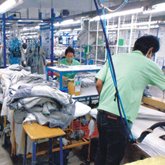Supply-Chain Software Tapped to Manage Calif. Human-Trafficking Law
When California’s new Transparency in Supply Chains Act went into effect on Jan. 1, apparel companies found themselves under increased scrutiny to disclose their efforts to eradicate slavery and human trafficking from their supply chains.
Known as SB657, the act mandates that all retailers and manufacturers doing business in California with annual worldwide gross receipts over $100 million must provide verification of transparency by monitoring supplier information and providing training for company employees and supply-management staff on human trafficking and slavery.
California companies that fall below the $100 million annual-sales threshold can all find themselves required to provide similar information to their major retailers and customers who do meet the law’s threshold.
“Organizations have to be able to keep track of compliance with their vendor base,” Bob McKee, industry strategy director for Lawson Software, said. “If you don’t have the tools to adhere to those things, then you’re always at risk of being out of accordance with the law.”
Information such as vendor reputation, employee hours and human-resource records, as well as ensuring that employees are not underage or unpaid, can be tracked using PLM (product lifecycle management), ERP (enterprise resource planning) or other supply- chain software systems.
Patagonia, long considered a leader in corporate social responsibility, is considering building its own database to keep tabs on the 91 factories the company works with in the United States, China, Colombia, Costa Rica, El Salvador, India, Israel, Jordan, Korea, Mexico, Nicaragua, the Philippines, Sri Lanka, Thailand, Turkey and Vietnam.
For now, the company is using a customized version of Microsoft Access, which is separate from the company’s PLM system. Patagonia uses PLM for tracking environmental adherence by factories, in addition to development and design of merchandise.
According to Cara Chacon, director of social and environmental responsibility for Patagonia, the company has always monitored whether a factory uses migrant or farm workers, or a third-party labor broker, but the Access database now has new fields to more easily highlight red flags, such as if there are a large number of foreign workers in a factory or the native countries of the factory workers.
In many cases, using a third-party labor broker could be sign of human trafficking, Chacon said.
“For any new factory, we’re going to screen to see if they can meet our social and environmental standards, and they go through an audit that has a whole section on imported workers and finding red flags for human trafficking and other human-rights issues,” she explained.
The company uses Access to store detailed factory information, including if an audit was performed by Patagonia or by an independent third party, when an audit was last performed, what the results of the audit were, and if there were any areas of non-compliance. The results can be viewed as a spreadsheet or dashboard and can even include details such as who pays for the airfare if a worker wants to return home for a visit.
“[SB657] made me take a hard look at what my management systems around human trafficking were,” Chacon said. “We did a lot of things really well—we’ve always had a lot of information collected at audits on foreign workers and labor brokers, but I found we could be doing it better. There were things we could be digging deeper on, such as more pointed questions around deposits and other fees that a worker might have to pay.”
Chacon also renamed a section of the database “Human Trafficking” and divided the types of workers that are potentially exploited into four categories—foreign/imported workers, migrant workers, contract workers and seasonal temporary workers—in order to more easily view the data.
The company has not decided yet if it will use a PLM or ERP system to continue screening this information or if it will create its own supply-chain database, but all of the current information in Access will be migrated to the new system, which will be cross-departmental and able to track quality, social and environmental data in one location, as well as allow factories to log in and add information themselves, Chacon said.
Tech tools for compliance
Lawson Software’s Lawson Fashion Solution provides a set of PLM, ERP and business intelligence software that can work independently or together to help monitor supplier information.
“The key issue is do you have places to store the appropriate information,” McKee said. “Anything that’s stored can be used for analytics and display, but if you don’t have the data elements to begin with, you’re in big trouble.”
Lawson’s PLM system focuses on vendor selection and compliance requirements set by the retailer. Once those are established, the system can trigger reminders to let production staff know if a supplier is due for an audit or certification. The database also works with its ERP system, which contains information relative to vendor performance, statistics, compliance and historical information. It can maintain notes on suppliers and permanent copies of records, including audits and independent quality bureau checks, which can be saved as a link, PDF, video or any other type of file.
Once the company has its data elements created, there are business intelligence components and reporting tools within the systems that can be used to display all of the information, McKee explained.
Lawson did not need to make any specific changes to its technology with the enactment of the new California act because the software already had the capability to monitor all of the necessary areas, McKee said. The difference is that now the affected companies will be required to use them.
Florida-based NGC Software uses a Web-based supply-chain management system to help companies monitor for social compliance.
Their e-SPS global sourcing software enables retailers to manage their supply chain from the time a purchase order is issued until the goods are received, and it also allows vendors and factories to log on and view and update information.
The system provides a database of vendors, which contains certifications, audit-compliance forms and a scorecard index in regards to how the vendor is performing so companies can easily choose an appropriate supplier.
“Customers can add additional information as needed—the type of machinery, what type of materials the factories are using, what types of processes they can handle, what are their minimum order qualities or employment qualifications, and the employment ledger,” said Mark Burstein, NGC’s president of sales, marketing, and research and development.
The software also provides calendar tracking for certifications and audits, as well as an alert system to message the production staff if a vendor is out of compliance or if its certification is set to expire. It also allows for different language capabilities so that companies can have their codes of conduct translated into a local language so factories can understand the expectations of the vendor.
Burstein said the new act has created an increase in business for NGC that started about a year ago.
“Our sales are really strong right now, and a lot of it has to do with this legislation and because of the need to track and manage more closely,” he said. “Most of [the companies] were doing it all along, but it wasn’t a formal process, and they didn’t have a tool. Now companies are looking for tools in order to comply.”























